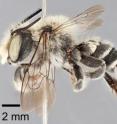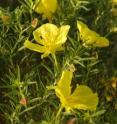Let me introduce myself -- leafcutter bee Megachile chomskyi from Texas
Related images
(click to enlarge)
The genus Megachile is a cosmopolitan group of solitary bees, often called leafcutter bees. This is one of the largest genera of bees, with well over 1,500 species in over 50 subgenera. A new species, Megachile chomskyi, has been found only in Texas, US. What is specific and interesting about this bee is the fact that it is among those insects which exhibit a narrow, specialized preference for pollen sources. Presumably, the irreplaceable host of M. chomskyi are the beautiful flowers of the widespread Onagraceae, or the so-called Evening-Primrose Family. The study has been recently published in the peer review, open access journal ZooKeys, with distribution data available via Canadensys.
The new species is named after Professor Noam Chomsky, Department of Linguistics & Philosophy at the Massachusetts Institute of Technology, for his long career and many academic achievements and contributions as a linguist, philosopher, cognitive scientist, historian, political critic, activist and global champion of human rights. Previously, Prof. Chomsky had inspired the name of another animal, the chimpanzee Nim Chimpsky, who was a part of an extended study of animal language acquisition at Columbia University. The pun referred to Chomsky's influential role in the development of modern linguistics, including in the ongoing debate about what aspects of language are unique to humans.
The most prominent features of M. chomskyi and the other members of this species group in the subgenus Megachiloides are their elongate tongues and the unique mandible structure of the females. Unlike the other representatives of the family that chew leaves or flower petals, many species of Megachile neatly cut circular pieces of leaves or petals for nest construction. Nests of Megachile are often constructed within hollow twigs or other similarly constricted natural cavities, but some species, including members of the subgenus Megachiloides, excavate burrows in the ground.
The subgenus Megachiloides still remains one of the most problematic Megachile groups in North America, partially due to males and females of many species not being associated with each other; as such, a large proportion of the species are described from one sex. Outdated identification keys and descriptions which are poorly illustrated are also contributing factors.
"In addition to naming the species after Dr. Chomsky to honour his many accomplishments, I also have been a huge fan and follower of his writings, lectures, and political views for a long time," said Dr Cory Sheffield, the author of the study.
Source: Pensoft Publishers
Other sources
- Let me introduce myself -- leafcutter bee Megachile chomskyi from Texasfrom Science DailyFri, 5 Apr 2013, 15:00:39 UTC
- Let me introduce myself: Leafcutter bee Megachile chomskyi from Texasfrom PhysorgThu, 4 Apr 2013, 15:30:59 UTC


